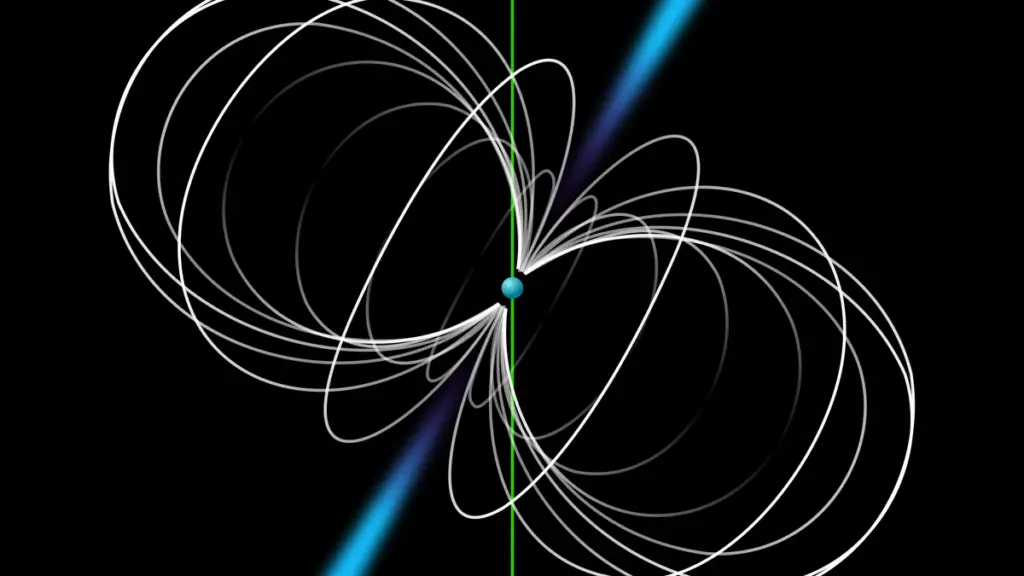A schematic diagram of a pulsar is shown. The sphere at the centre represents the neutron star, the curves indicate the magnetic field lines, and the two cones show the emitted radiation. The green line represents the pulsar’s axis of rotation. The photo credit goes to Mysid (CC BY-SA 3.0).
The year was 1967, a time when the Nathu La and Cho La clashes between the Indian and Chinese armies had just concluded, a war was raging in Vietnam, and the space race was at its peak. It was during this period that a group of astronomers at the University of Cambridge assembled an array of antennae to be used as a telescope for studying the radio waves emitted by distant stars.
As the group began operating the array, Jocelyn Bell Burnell and Antony Hewish, two members of the group, noticed a set of signals flashing in a periodic manner. At the time, they were unaware of its origins. However, it is now known that the pair had discovered the first pulsar, named PSR B1919+21.
The discovery of the pulsar was closely related to the neutron, a discovery made by James Chadwick in 1932. Neutrons, when in a group, are not allowed to have the same energies and will settle for the lowest available energy level. If gravity attempts to compress this collection of neutrons inward, their inability to ‘merge’ into a common energy level will resist with an outward pressure.
When heavy stars die, their cores implode. If they are heavy enough, they become black holes, but if not, they collapse just enough to form a ball of neutrons, with gravity not being strong enough to overwhelm their outward pressure. This compact, super-dense object is called a neutron star.
When the Cambridge group reported their discovery of the pulsar, other scientists proposed several possibilities for the origin of the unusual pulsating signal, including extraterrestrial civilizations. However, it was ultimately determined that the signals came from a very small patch of the sky and repeated frequently, leading scientists to identify pulsars as rotating neutron stars.
Physicists soon discovered that the rotation of these neutron stars slowed over time and determined that the energy saved by reducing the rotation rate was used to accelerate electric charges outside the star, producing the radio signals. This explanation fit their theories neatly until a problem was discovered in 1969.
Two research groups, working separately, reported an abrupt and brief increase in the rotation rate of the pulsar PSR 0833-45. This glitch remains to be explained 44 years on, although physicists have some ideas. To date, they have spotted more than 3,000 pulsars and around 700 such glitches, leading to the development of hypotheses about what these glitches are and why they occur.
When scientists plotted the rotation rate of pulsars over time on a graph, they observed a familiar decreasing pattern. During a glitch, the rate increases briefly before relaxing to the original value. They found this process to be quite slow, which hinted that the inside of the neutron star was made primarily of regular matter, and all internal relative motions should be damped quickly by friction. However, the slow post-glitch relaxation suggested that the neutrons inside the star were in a slippery, frictionless state, which physicists called a superfluid.
Superfluids have unique properties, with vortices forming when set in motion inside a container. These vortices have intriguing ramifications for the pulsar.
The neutron star is a 20-km-wide sphere with a solid crust and a core. The crust is believed to be a lattice of iron-like nuclei interspersed with neutron superfluid, while the core predominantly contains the superfluid and no solid parts. The presence of the superfluid in a rotating system implies the existence of vortices. The vortices have less energy when they attach themselves to the nuclei in the crust, a phenomenon called pinning.
As the rotating neutron star loses energy to radiation, the crust slows down, while the pinned vortices maintain the speed of the superfluid’s rotation. The speed difference between the crust and the superfluid leads to a force on the vortices that eventually overcomes the pinning. This results in the vortices being thrown outward, reducing the speed of the superfluid, and causing the neutron star to experience a brief increase in rotation, known as a glitch.
The topic of these glitches is a fertile bed for scientific inquiry that could help us understand the variety of physics unfolding inside a neutron star.
As Ghalib said, “The stars are one thing and appear another; these tricksters fool us openly.”
The author is a fourth year Ph.D. scholar in the Department of Physics at Ashoka University.


